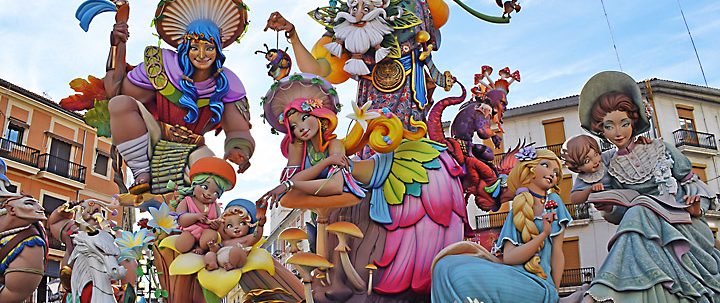Now that we are in March, I would like to introduce you the Fallas festival. The Fallas was added to UNESCO’s intangible cultural heritage of humanity list on 30 November 2016.
In the middle of the Mediterranean coast, Valencia city, celebrates each year the final days of the winter and the arrival of spring with spectacular fires and pyrotechnics. From the 1st to 19th March, Valencia is overturned by Fallas celebrations, a festivity that combines tradition, satire and art which shouldn’t be missed for anything in the world. Read on to learn where our passion for fire and fun comes from and you’ll be ready to enjoy Fallas like a Valencian.
The origin of las Fallas comes from the old carpenter’s tradition who, when celebrating the arrival of spring on 19th March, used to burn pieces of wood that were used to prop up their lights during the winter. To this bonfire they gradually started to add old belongings and rags, which gave the wooden structure a human-looking aspect, until they became the ninots that we know today. The Valencian sense of humor soon gave the irony shown in the ninots which is maintained at present. The Fallas celebrations have evolved into temporary works of art which, in some cases, cost millions of euros.
Each neighborhood of the city has an organized group of people, the Casal faller, that works all year long holding fundraising parties and dinners. Each casal faller produces a construction known as a falla which is eventually burned. A casal faller is also known as a comissió fallera and currently there are approximately 400 registered in Valencia
Displayed on every corner all over the city are colorful ninots, giant papier-mâché figures often 20 feet tall or even more that have been paraded through the streets and then placed in fantasy groups to tower over excited spectators. Each one in some way satirizes a political figure, or a soap star, or more exotic creatures from the movies, TV, sports idols, or simply imagination. Some of them are grotesque, others playful and charming, all are larger than life and up for public scrutiny.
Mascletà, from 1st to 19th Every day at 2pm firecrackers rip through the Plaza del Ayuntamiento in a noisy event called la Mascleta. This concert of gunpowder is very popular and involves different neighborhood groups competing for the most impressive volley, ending with the terremoto, (literally means “earthquake”) as hundreds of masclets exploiting simultaneously. At 2:00 pm the clock chimes and the Fallera Major, dressed in her fallera finery, will call from the balcony of City Hall, Senyor/a pirotècnic/a, pot començar la mascletà! (“Mr./Ms. Pyrotechnic, you may commence the Mascletà!”), and the Mascletà begins.
The Mascletà is almost unique to the Valencian Community, and very popular with the Valencian people. Smaller neighborhoods often hold their own mascletà for saints’ days, weddings and other celebrations.
The Plantà, 15th March The night of the 15th of March is full of activity. The Fallas commissions work in shifts because all the monuments that are set up in Valencia must be fully finished by the morning of 16th. That is the day that the judges award the best ones and choose the ninot induldat, the only figure to be saved from the burning.
Award-giving, 17th March The falleras mayores and their commissions take part in a procession towards Plaza del Ayuntamiento on the morning of 17th, to pick up their prizes. You should know that the more than 750 monuments that are set up in Valencia, are divided into categories with the Special Section being the most impressive of all.
Fireworks and the Nit del Foc, from 15th to 19th March The night skies are filled with light and color during Fallas thanks to the impressive firework displays which are set off at midnight at Alameda. An act which brings together a multitude of people and reaches its peak with the Nit del Foc, a unique firework display celebrated in the early hours of the 18th.
Flower Ofrenda, 17th and 18th March Another important event is the Flower Ofrenda to the Virgen de los Desamparados (Our Lady of the Abandoned, is a Catholic invocation of the Virgin Mary. She is the patroness of Valencia), a beautiful ceremony every March 17 and 18, that honors Valencia’s patron Virgin. Thousands of Falleras and Falleros arrive to the city from every corner of the Comunitat (Valencia State) and take the streets wearing traditional costumes and dancing to their neighborhood or village bands as they wend their way to the Plaza de la Virgen to offer bouquets to the giant image of the Virgin.
The Cremà, 19th March On the final night of FallasAll the Fallas, small and large, must be burned. This is known as La Cremà (the Burning), the climax of the whole event, and the reason why the constructions are called fallas (“torches”). Although it’s a shame, seeing how the flames reduce these monuments to ash is an artwork in itself. The cremà route begins at 8:00PM when the small monuments start to burn, and at 10:00pm the big ones go up in flames, except for the 1st prize-winner which is burned at 10.30pm. The Fallas celebrations end when traditionally, the falla in the Plaza del Ayuntamiento is burned, at 11pm.



